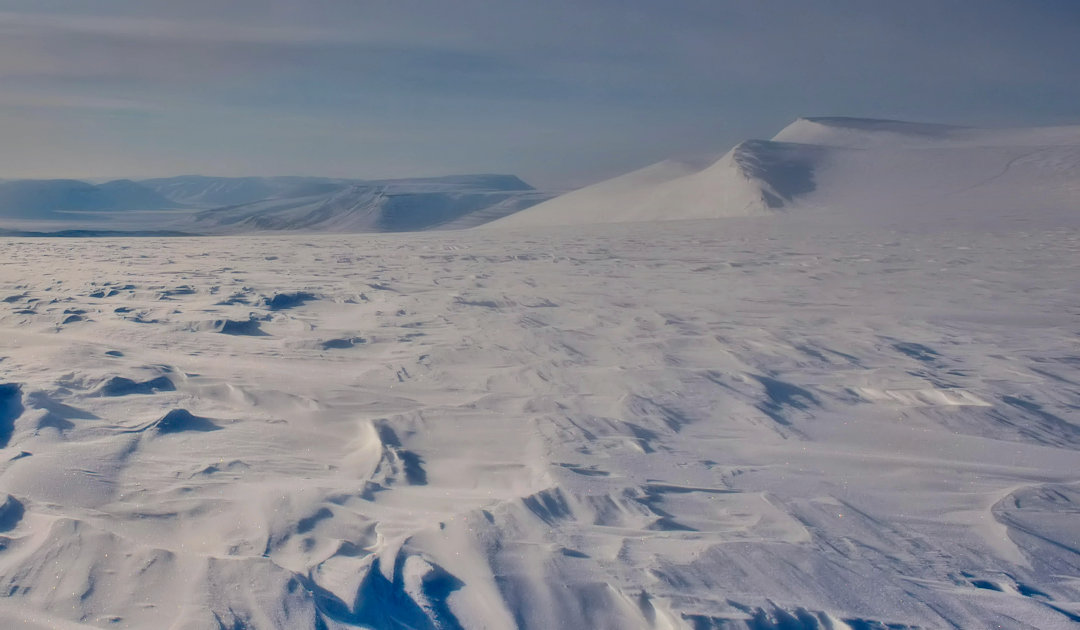
For some time now, an abbreviation has been making headlines around the world: PFAS. This stands for per- and polyfluorinated alkyl compound and is commonly known as an “forever chemicals” because they can last hundreds of years in the environment. Because they are also considered pollutants to humans and the environment, they have also been increasingly under- and sought after in recent years. And it now appears that the substances have reached virtually all areas of the earth, even the Svalbard archipelago.
An ice core more than 12 meters long from the Lomonosov ice cap of Svalbard contains 26 different PFAS in a wide variety of concentrations, some of which are alarmingly high. These substances, which most likely originate from northern Eurasia and were deposited on Svalbard by air masses, can enter the waters of the fjords through melting processes and thus enter the food chain. This endangers animal and plant species that are already under severe pressure from climate change. This is the result of a study recently published by a team of scientists from Great Britain, Svalbard, Sweden, Spain and Norway in the journal Science of the Total Environment has published.


The fact that PFAS are deposited in the ice of Svalbard is not particularly surprising. After all, the pollutants have now been discovered in so many systems that one can quietly speak of a global problem. Due to their persistence and longevity, the substances accumulate in food webs, and the higher the animal, the greater the accumulation. Polar bears and seals in the Arctic are therefore particularly at risk. The research team also warns of this in their study. Their results suggest that the pollutants enter the fjords through the melting processes of the ice cap and thus enter the Arctic food web. Some of the substances are already known to negatively affect the health and development of embryos. An accumulation of such pollutants may therefore further stress Arctic organisms that are already struggling with the direct effects of warming and increasing competition.



The ice core, taken in April 2019, came from the Lomonosov Ice Cap, a roughly 600-square-kilometer ice sheet on the main island of Spitsbergen, located about 80 kilometers northeast of Longyearbyen. “Ice cores can provide records of several years of snow accumulation and thus a pathway to understanding PFAS sources in the atmosphere and transformation processes,” writes the research team, led by Dr. William Hartz of Oxford University and Dr. Roland Kallenborn of the Norwegian University of Life Science. “A study of 22 sites on Svalbard glaciers identified Lomonosovfonna as an optimal site to investigate long-range pollution deposition.” The team dated the core to be about 12 to 13 years old using isotope and other material analyses. In the different layers, they searched for 45 different known PFASs, of which they were able to identify 26 in the end. In particular, the team was able to detect PFOS (perfluorooctane sulfonic acid), which is considered particularly hazardous to health, in almost all of the core samples. The team suspects that the precursors were transported to Svalbard by air masses from various parts of northern Eurasia. Chemical processes in the atmosphere, especially under the influence of solar radiation and hydrogen radicals, produced PFOS, which were deposited with precipitation on the ice cap, which is the highest elevated cap on Svalbard. Further results also showed that over the years these deposits have been steadily increasing and is a trend that is also occurring in other parts of the Arctic.

PFAS are a class of substances consisting of various short- and long-chain molecules and compounds, and little or no information is known about the properties, transport or toxic effects of most of them. A group of experts led by the Helmholtz Center HEREON in Germany is working with international partners to build an information site, the “PFAS Explorer” within the Coastal Pollution Toolbox, to give the public the opportunity to follow the current state of knowledge about these pollutants. The aim is not only to focus on the scientific aspect, but also on the regulatory and political aspects. In some countries, especially in Europe, legislators are now also addressing the issue and there are proposals on the table to ban substances that lead to the formation of PFAS and similar compounds. But because the conventional detection methods used so far can only detect a small fraction of the substances, there are probably many more “forever chemicals” in the drill core from the ice cap and in many other samples.
Dr Michael Wenger, PolarJournal
More on the topic





